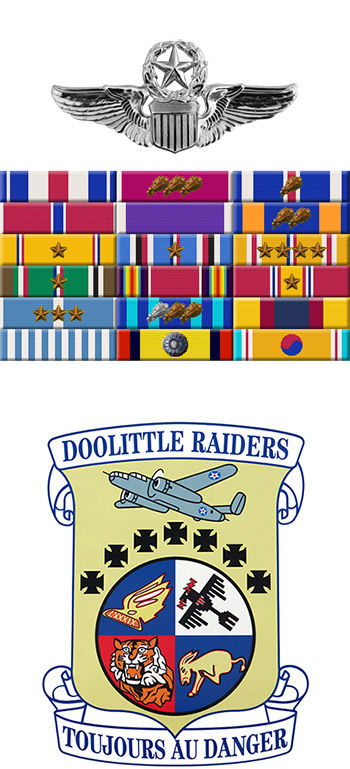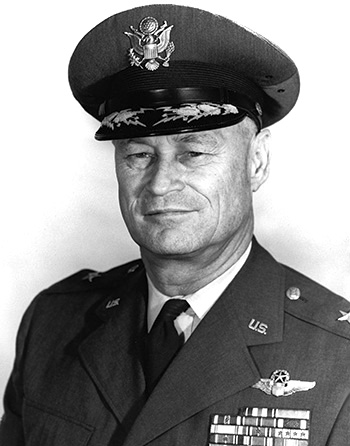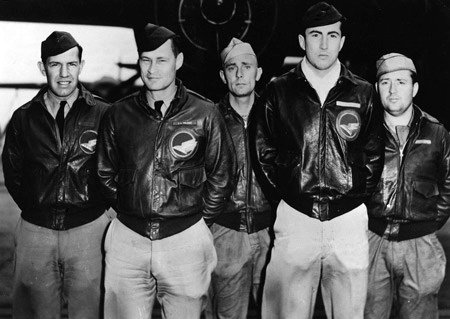
|
John A. Hilger |
 |
|||
| Rank, Service | ||||
Brigadier General O-7, U.S. Air Force |
||||
| Veteran of: | ||||
|
||||
| Tribute: | ||||
John Hilger was born on January 11, 1909, in Sherman, Texas. He was commissioned a 2d Lt of Infantry in the U.S. Army Reserve through the Army ROTC program at Texas A&M in May 1932, and resigned his commission to enlist in the Army Air Corps as a Flying Cadet on February 21, 1933. Hilger was awarded his pilot wings in February 1934, and was commissioned a 2d Lt in the Army Air Corps on February 21, 1935. His first assignment was as a pilot, assistant base adjutant, and commander of the base photographic section at March Field, California, from February 1935 to May 1940, followed by service as a B-18 Bolo, B-23 Dragon, and B-25 Mitchell pilot, and as Commander of the 89th Reconnaissance Squadron at McChord Field, Washington, from May 1940 until he was selected for the Doolittle Mission in February 1942. Maj Hilger served as the pilot on the 14th B-25 to take off from the aircraft carrier USS Hornet (CV-8) on April 18, 1942, and after bombing targets in and around Nagoya, Japan, the crew flew to China and bailed out when their aircraft ran out of fuel. His next assignment was as a B-26 Marauder pilot and Commanding Officer of the 320th Bomb Group at MacDill Field, Florida, from July to October 1942, and then as B-26 pilot and Commanding Officer of the 344th Bomb Group at MacDill Field and then at Drane Field, Florida, from October 1942 to July 1943. Col Hilger served as Commanding Officer of the Operational Training Unit Bomb Group with the 14th Air Force in Kunming, China, from July to October 1943, followed by service as Chief of the Organization Division with Headquarters Army Air Force Tactical Center at Orlando, Florida, from November 1943 to June 1944. His next assignment was as Assistant Chief of the Evaluation Division with the 3rd Army Air Force Base Unit at Orlando from July to September 1944, and then as Future Plans Officer on the staff of Fleet Admiral Chester W. Nimitz, Commander in Chief, Pacific Ocean Areas, from September 1944 to January 1946. His next assignment was as a Staff Officer and then as Chief of the Internal Policy Branch Division with Headquarters U.S. Army Air Forces and then Headquarters U.S. Air Force in the Pentagon from January 1946 to August 1948, followed by Air War College at Maxwell AFB, Alabama, from August 1948 to June 1949. Col Hilger was assigned to the 307th Bomb Wing at MacDill AFB while on TDY to Headquarters Strategic Air Command from June to August 1949, and he then served as a B-29 Superfortress pilot and Commander of the 306th Bomb Group at MacDill AFB from September 1949 to March 1950. His next assignment was as Commander of the 307th Bomb Group at MacDill AFB, and deployed to Kadena AB, Okinawa, in support of the Korean War, from March to December 1950, followed by service on the Staff of the 307th Bomb Wing and then as Commander of the 307th Bomb Wing at Kadena from December 1950 to April 1951. He served as Director of Operations with Headquarters 6th Air Division at MacDill AFB from April to August 1951, and then attended National War College in Washington, D.C., from August 1951 to June 1952. Gen Hilger served as Chief of the Allocations Division in the Directorate of Operations with Headquarters U.S. Air Force in the Pentagon from June 1952 to July 1955, followed by service as Commander of the Air Force Operational Test Center with Air Proving Ground Command at Eglin AFB, Florida, from July 1955 to June 1957. His next assignment was as Commander of the U.S. Air Force Group, Joint U.S. Military Mission for Aid to Turkey, in Ankara, Turkey, from June 1957 to June 1959, and then as Chief of Staff, Allied Air Forces Northern Europe in Oslo, Norway, from July 1959 to July 1961. Gen Hilger served as Chief of Staff of Air Training Command at Randolph AFB, Texas, from August 1961 to July 1964, followed by service as Deputy Chief of Staff for LIVE OAK, and as Chief of the United States Element for LIVE OAK, a secret contingency planning staff whose mission was to develop military measures to keep the air and land corridors between West Germany and West Berlin open at all times, in Europe from July 1964 until his retirement from the Air Force on November 30, 1966. John Hilger died on February 3, 1982, and his remains were cremated and scattered off the coast of Newport Beach, California. |
||||
|
||||


